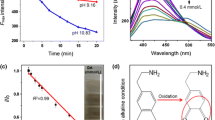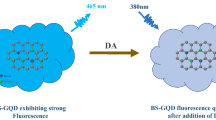Abstract
Dopamine (DA) is a neuromodulatory molecule that plays critical roles in many biological processes. The dysfunctions of the DA system are closely associated with several nervous system diseases. Therefore, it is urgent to establish a simple and accurate method for DA analysis. In this study, an economic and accurate DA ratiometric sensor was established using dual-emission carbon dots (DE-CDs). DE-CDs were first synthesized by the one-step solvothermal method and two separate fluorescence emission peaks at 340 and 500 nm were observed under the excitation of 310 nm. In the presence of Hg2+, the fluorescence signal at 340 nm was significantly quenched, while the signal at 500 nm keeps stable. Upon adding DA, the quenched signal at 340 nm was significantly recovered, whereas the signal at 500 nm remains stable. Therefore, a novel ratiometric sensor for DA analysis was established. This method shows a good linear range from 500 nM to 100 μM, and the detection limit was calculated to be 80 nM. Moreover, this established method shows excellent specificity and could be applied in real sample analysis, showing great potential for application in clinical research.
Graphical abstract







Similar content being viewed by others
Data availability
The authors declare that the data supporting the findings of this study are available within the paper and its Supplementary Information files. Should any raw data files be needed in another format, they are available from the corresponding author upon reasonable request.
References
X. Wei, Z. Zhang, Z. Wang, A simple dopamine detection method based on fluorescence analysis and dopamine polymerization. Microchem. J. 145, 55–58 (2019)
Y. Lan, F. Yuan, T.H. Fereja, C. Wang, B. Lou, J. Li, G. Xu, Chemiluminescence of lucigenin/riboflavin and its application for selective and sensitive dopamine detection. Anal. Chem. 91, 2135–2139 (2018)
R.A. McCutcheon, A. Abi-Dargham, O.D. Howes, Schizophrenia, dopamine and the striatum: from biology to symptoms. Trends Neurosci. 42, 205–220 (2019)
D. Meder, D.M. Herz, J.B. Rowe, S. Lehéricy, H.R. Siebner, The role of dopamine in the brain-lessons learned from Parkinson’s disease. Neuroimage 190, 79–93 (2019)
E.T. Koch, L.A. Raymond, Dysfunctional striatal dopamine signaling in Huntington’s disease. J. Neurosci. Res. 97, 1636–1654 (2019)
L. Zhang, Z. Tang, Y. Dong, Silicon quantum dot involved luminol chemiluminescence and its sensitive detection of dopamine. Anal. Methods 10, 4129–4135 (2018)
Y. Sun, Y. Lin, C. Ding, W. Sun, Y. Dai, X. Zhu, H. Liu, C. Luo, An ultrasensitive and ultraselective chemiluminescence aptasensor for dopamine detection based on aptamers modified magnetic mesoporous silica@ graphite oxide polymers. Sens Actuators B: Chem. 257, 312–323 (2018)
X. Ren, Q. Zhang, J. Yang, X. Zhang, X. Zhang, Y. Zhang, L. Huang, C. Xu, Y. Ge, H. Chen, Dopamine imaging in living cells and retina by surface-enhanced Raman scattering based on functionalized gold nanoparticles. Anal. Chem. 93, 10841–10849 (2021)
L. Li, Y. Lu, Z. Qian, Z. Yang, K. Yang, S. Zong, Z. Wang, Y. Cui, Ultra-sensitive surface enhanced Raman spectroscopy sensor for in-situ monitoring of dopamine release using zipper-like ortho-nanodimers. Biosens. Bioelectron. 180, 113100 (2021)
X. Hou, W. Huang, Y. Tong, M. Tian, Hollow dummy template imprinted boronate-modified polymers for extraction of norepinephrine, epinephrine and dopamine prior to quantitation by HPLC. Microchim. Acta 186, 1–9 (2019)
F. Chen, B. Fang, S. Wang, A fast and validated HPLC method for simultaneous determination of dopamine, dobutamine, phentolamine, furosemide, and aminophylline in infusion samples and injection formulations. J. Anal. Methods Chem. 2021, 1 (2021)
Y. Ma, A. Chen, X. Xie, X. Wang, D. Wang, P. Wang, H. Li, J. Yang, Y. Li, Doping effect and fluorescence quenching mechanism of N-doped graphene quantum dots in the detection of dopamine. Talanta 196, 563–571 (2019)
J. Liu, R. Li, B. Yang, Carbon dots: A new type of carbon-based nanomaterial with wide applications. ACS Central Sci 6, 2179–2195 (2020)
Z. Kang, S.-T. Lee, Carbon dots: advances in nanocarbon applications. Nanoscale 11, 19214–19224 (2019)
L. Yue, H. Li, Q. Sun, J. Zhang, X. Luo, F. Wu, X. Zhu, Red-emissive ruthenium-containing carbon dots for bioimaging and photodynamic cancer therapy. ACS Appl Nano Mater 3, 869–876 (2020)
T. Kong, L. Hao, Y. Wei, X. Cai, B. Zhu, Doxorubicin conjugated carbon dots as a drug delivery system for human breast cancer therapy. Cell Prolif. 51, e12488 (2018)
D. Yoo, Y. Park, B. Cheon, M.-H. Park, Carbon dots as an effective fluorescent sensing platform for metal ion detection. Nanoscale Res. Lett. 14, 1–13 (2019)
S. Wu, H. Min, W. Shi, P. Cheng, Multicenter metal–organic framework-based ratiometric fluorescent sensors. Adv. Mater. 32, 1805871 (2020)
X. Xu, D. Ren, Y. Chai, X. Cheng, J. Mei, J. Bao, F. Wei, G. Xu, Q. Hu, Y. Cen, Dual-emission carbon dots-based fluorescent probe for ratiometric sensing of Fe (III) and pyrophosphate in biological samples. Sens Actuators B: Chem 298, 126829 (2019)
Y. Hiruta, N. Yoshizawa, D. Citterio, K. Suzuki, Highly durable double sol–gel layer ratiometric fluorescent pH optode based on the combination of two types of quantum dots and absorbing pH indicators. Anal. Chem. 84, 10650–10656 (2012)
L. Xie, Y. Qin, H.-Y. Chen, Polymeric optodes based on upconverting nanorods for fluorescent measurements of pH and metal ions in blood samples. Anal. Chem. 84, 1969–1974 (2012)
R.C. Castro, R.N. Páscoa, M.L.M. Saraiva, J.L. Santos, D.S.J.S.A.P.A.M. Ribeiro, Spectroscopy, B Photoluminescent and visual determination of ibandronic acid using a carbon dots/AgInS2 quantum dots ratiometric sensing platform. Spectrochim. Acta Part A Mol. Biomol. Spectrosc. 267, 120592 (2022)
H. Zhang, Y. Chen, M. Liang, L. Xu, S. Qi, H. Chen, X. Chen, Solid-phase synthesis of highly fluorescent nitrogen-doped carbon dots for sensitive and selective probing ferric ions in living cells. Anal. Chem. 86, 9846–9852 (2014)
J. Zhou, T. Han, H. Ma, T. Yan, X. Pang, Y. Li, Q. Wei, A novel electrochemiluminescent immunosensor based on the quenching effect of aminated graphene on nitrogen-doped carbon quantum dots. Anal. Chim. Acta 889, 82–89 (2015)
Y. Zhang, J. Wang, W. Wu, C. Li, H. Ma, A Green, Economic “Switch-On” Sensor for Cefixime Analysis Based on Black Soya Bean Carbon Quantum Dots. J. AOAC Int. 103, 1230–1236 (2020)
X. Jiang, H. Jin, Y. Sun, R. Gui, Colorimetric and fluorometric dual-channel ratiometric determination of fungicide cymoxanil based on analyte-induced aggregation of silver nanoparticles and dually emitting carbon dots. Microchim. Acta 186, 1–12 (2019)
A. Sharma, T. Gadly, S. Neogy, S.K. Ghosh, M. Kumbhakar, Molecular origin and self-assembly of fluorescent carbon nanodots in polar solvents. J. Phys. Chem. Lett. 8, 1044–1052 (2017)
W. Zhou, J. Zhuang, W. Li, C. Hu, B. Lei, Y. Liu, Towards efficient dual-emissive carbon dots through sulfur and nitrogen co-doped. J Mater Chem C 5, 8014–8021 (2017)
M. Zhang, R. Su, J. Zhong, L. Fei, W. Cai, Q. Guan, W. Li, N. Li, Y. Chen, L. Cai, Red/orange dual-emissive carbon dots for pH sensing and cell imaging. Nano Res. 12, 815–821 (2019)
Funding
This work was funded by National Natural Science Foundation of China, 22264023, Lingbo Sun, Scientific Research Projects of Education Department of Shaanxi Provincial Government, 22JK0614, Yuecheng Zhang, Health Research Project of Shaanxi Province, 2022E019, Lingbo Sun, PhD start-up fund of Yan’an University, YDBK2020-30, Lingbo Sun, YDBK2022-15, Yuecheng Zhang.
Author information
Authors and Affiliations
Corresponding authors
Ethics declarations
Conflict of interest
On behalf of all authors, the corresponding author states that there is no conflict of interest.
Supplementary Information
Below is the link to the electronic supplementary material.
Rights and permissions
Springer Nature or its licensor (e.g. a society or other partner) holds exclusive rights to this article under a publishing agreement with the author(s) or other rightsholder(s); author self-archiving of the accepted manuscript version of this article is solely governed by the terms of such publishing agreement and applicable law.
About this article
Cite this article
Zhang, Y., Sun, L., Li, C. et al. A simple and accurate ratiometric sensor for determination of dopamine based on dual-emission carbon dots. ANAL. SCI. (2024). https://doi.org/10.1007/s44211-023-00492-5
Received:
Accepted:
Published:
DOI: https://doi.org/10.1007/s44211-023-00492-5




